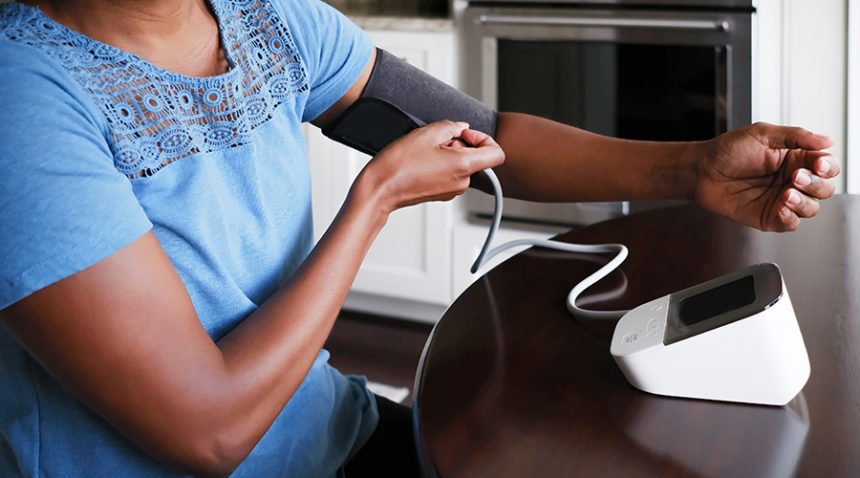A major cause of premature death worldwide, hypertension—or high blood pressure—affects 68 million Americans. That’s 1 in every 3 U.S. adults. High blood pressure usually shows no symptoms, yet it puts you at increased risk for heart disease, heart failure, stroke and kidney disease, among other life-threatening complications.
And if you didn’t have high blood pressure before, there’s a chance you do now. That’s because the American Heart Association and the American College of Cardiology have updated their guidelines for what is considered hypertension.
“The new guidelines changed based on new evidence from several important studies that had been presented over the past three to five years,” says UNC Health cardiologist Sidney C. Smith Jr., MD, a member of the guideline writing group and a past president of the American Heart Association. “The major change was the understanding that we should be treating patients at a much lower blood pressure.”
A Lower Threshold for High Blood Pressure
Blood pressure is measured using two numbers. The first, or top, number is called systolic blood pressure. It measures the pressure in your blood vessels when your heart beats. The second, or bottom, number is called diastolic blood pressure, which measures the pressure in your blood vessels when the heart rests between beats.
For years, hypertension was classified as a blood pressure reading of 140/90 mmHg or higher. In 2017, a clinical study called the Systolic Blood Pressure Intervention Trial (SPRINT) found that lowering the guidelines for hypertension helped better prevent cardiovascular problems in people with a higher baseline risk for cardiovascular disease. Those at risk could be treated earlier—and were more likely to avoid complications and worsening disease as a result.
The updated guidelines classify hypertension as a blood pressure reading of 130/80 mmHg or higher. For example, someone who previously had a reading of 133/82, which was not considered high blood pressure then, is now identified has having hypertension by the new measure.
“We now define normal blood pressure as less than 120/80, so if you have a systolic reading of 120 to 129 mmHg or a diastolic reading of 80 to 89 mmHg, it is considered elevated blood pressure, and you need to institute behavioral changes for blood pressure lowering,” Dr. Smith says.
The SPRINT study found that helping patients lower their systolic pressure to no more than 120 mmHg reduced the chance of heart attacks, heart failure and stoke over a three-year period.
Lifestyle Changes Can Help Lower Blood Pressure
Eating a healthier diet with less salt, exercising regularly, stopping smoking and cutting down on alcohol consumption can help lower blood pressure.
“Behavior modifications for lowering blood pressure are the foundation of what we do,” Dr. Smith says. “You can help reduce your blood pressure with regular exercise, which may be something as easy as walking daily for a half an hour, or even two 15-minute walks.”
Keep your salt intake to less than 2,300 milligrams per day. When it comes to cutting the amount of salt in your diet, reading labels is important.
“Most of the salt in our diet in the United States is not coming from the saltshaker, although we should be careful not to add salt to food. It comes from food itself. It’s in processed meats and even bread,” Dr. Smith says. “The Mediterranean diet is a good one to follow.”
The Mediterranean diet is based on Mediterranean food culture—you eat fruit, vegetables, whole grains, nuts and legumes, along with fish and chicken. Red meat and dairy products are allowed but should be eaten less often. Instead of salt, use herbs and spices for flavor and olive oil instead of butter. The Mediterranean diet also limits alcohol intake.
If you continue to have hypertension, your doctor may start you on blood pressure medication.
“We’ve got medications and combinations of medications that can help,” Dr. Smith says. “We’ve learned that increasing the dosage of one all the way up to its maximum strength and then adding another is not as useful as having two medications at a moderate dose, which can be more effective in lowering blood pressure and less likely to have side effects that would be associated with one medication.”
Know Your Blood Pressure Numbers
The only way to know if you have high blood pressure is to have your blood pressure tested. The new guidelines recommend that blood pressure be measured regularly, and they encourage people to use at-home blood pressure monitors in addition to checks at their doctor visits.
That’s because readings are sometimes higher at the doctor’s office because of “white-coat hypertension”—meaning people are often nervous at the clinic, Dr. Smith says.
“It is important to keep track of your blood pressure if it is elevated. You can do that at home, away from the stress of the doctor’s office,” Dr. Smith says. “You can usually buy a good blood pressure cuff for $40 to $80. Measure your blood pressure in the morning and the evening. Measuring blood pressure at home is also important if you’re on medications to control your blood pressure.”
Concerned about your risk of hypertension? Talk to your doctor. Don’t have one? Find a doctor near you.

